by Briscoe White | Dec 22, 2010 | Basics, Containers, Flowers, Gardening, Herbs, Indoor Gardening, Miscellaneous |
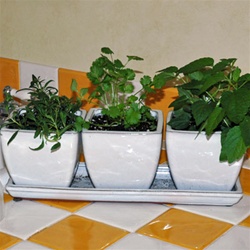
With winter here and in full force already (whether we like it or not), I’ve had to bring in a number of our outdoor plants. My first concern was to find space for all of the various sized pots and to make sure no one was going to trip over them. Once I had my living clutter settled in for the season, I began thinking about how to keep them healthy and happy throughout these long cold months, especially when we have everything from cacti to hardy herbs like Rosemary. Depending on what type of plants have moved into your home for the holidays, here are some general rules of thumb and just plain good advice for keeping them alive and well.
Lighting
We don’t think much about the amount of light outside as it changes from season to season, when we’re indoors and warm with electric lights, but this is a major factor for your plants. Especially with this time of year being the shortest amount of daylight we’ll see, you need to make sure your plants are getting the amount they need. Though probably dormant for the season, your flowering plants tend to like more light than evergreens, cacti and other foliage hardy plants. Whether you unsash your curtains, open the blinds or add additional artificial light, your plants will need a little UV boost through the winter. Even getting your hands on the best led grow lights will offer your plants with the right amount of sunlight that can help them to flourish in their surroundings. Make sure to turn them occasionally to allow all sides and leaves to get plenty of light. This will also help them from growing at a crooked angle, as most tend to grow towards a light source.
Water
If you’re feeling dried out from running your heat on high, chances are that your plants may be, too. Make sure to water them appropriately. Excluding cacti and other succulents, an easy way to tell if your plant needs water is to stick your finger partially into the dirt to test it. If it’s bone dry, don’t drown it. Water moderately and monitor its progress. If you find that your plants are needing water at alarming rates, check to see where you have them placed. On top of a radiator or next to your fireplace may be too hot for their liking.
Temperature
So, you’ve moved your little green friends indoors and you figure that should keep them safe from the temperatures, right? Think again. Some plants can be highly sensitive to heat and cold so make sure you aren’t placing your Basil plant near a cold, drafty vent or your Lemongrass right beside your wood furnace. Depending on their particular needs, temperature can even speed and slow the growth process for your plants, just like an artificial changing of the seasons. For example, with Amaryllises, because they are flowering bulbs, temperature plays a huge part in their growth cycle. We brought some in from the greenhouse for the holidays and the ones placed near our radiator bloomed in a week! I guess we tricked them into thinking it was Spring!
Cleaning and Prevention
Another great thing about having your plants close at hand when it’s too cold to go outside, is that you can’t help but to notice them. The winter months are a great time to get to know your plants’ personalities and to give them a good cleaning. Dust and microscopic debris build up on the plant’s leaves which can block sunlight and the plant’s pores. Try cleaning the tops and bottoms of your plant’s leaves with a damp cloth to remove any unwanted buildup that may be hindering your plant from being its healthiest. While you’re at it, take a close look for insects and disease. For a longer lasting plant, it’s best to nip an infestation or blight in the bud. In most cases, warm water and a mild soap will do the trick to remove many common pests. For a deeper rooted problem, try an all natural pesticide or fungicide, which can be bought at your local hardware store.
Positioning
Plants prefer a routine and moving them into your home can be quite an adjustment. To alleviate further disruption to their transition indoors, try to find permanent spots for them when you bring them in. If you can place them in areas where they won’t be disturbed by the hustle and bustle of the holidays, pets, kids or just because they’re in the way, they’ll greatly appreciate it. Moving potted plants too often can really disrupt and unsettle their soil and root structure. Leaving them to settle in and stay sedentary will cause the least amount of stress on them, as leaves, stems, flowers and branches can break, become weak or tear during the moving process. This will also allow the roots to stay strongly grounded, as soil won’t be jostled about, loosening the plant’s hold.
Potting
Making sure your plants are in the best pot or container is also crucial to its health. Think about it. When you start to outgrow your shoes, the constriction and tightness is uncomfortable, right? Well, many plants need to be moved to larger containers as they get bigger to give them more adequate space to stretch and grow bigger. The winter is a great time for this as the cool temperatures make the process less stressful on your plants. Give your plants plenty of room to grow and you’ll get to enjoy larger and longer lasting results.
Once the stress of the holidays has wound down, indoor gardening can be a terrific therapeutic hobby…or, during the holidays if you need an escape from the madness! Gardening, in general, can actually make for a very fulfilling past time as it can keep you productive, environmentally-minded, creative and, by growing your own produce, can actually save you money. For other hobby ideas, be sure to visit this website – https://tlhobbyideas.com. Gardening year round allows you to enjoy the fruits of your hard work constantly and the calming presence of your indoor plants will bring beauty and fresh aroma to these bleak winter days. Many plants can be easily started indoors during the colder months, for transplant in the spring to an outdoor garden. Try growing your favorite culinary herbs indoors this season to spice things up in your stews and other hearty recipes or just to lend a savory fragrance to your home. By growing now, you will be more prepared once spring gets here!
by Briscoe White | Aug 12, 2010 | Flowers, Growing |
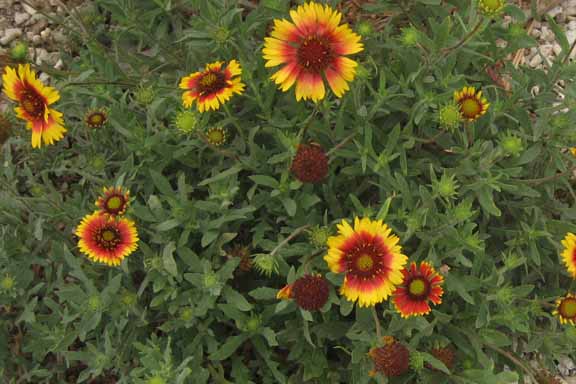
Of all the beach flowers, Gaillardia is the only one that is there by choice. In yards which are irrigated, Oleander, Rudbeckia, and Rosemary grow well. But how many volunteers do you see growing out in the dunes? My late summer visit to the NC beach found the dunes blanketed in Blanket Flower. No individuals were large bunched plants like their kin growing with a gardeners care and regular water. All the little Gaillardia plants were single stem with a flower or two per plant. They made up for individual size by shear numbers. The vacant lot next to the walk over the dunes was completely filled as if sown on purpose. With little or no competition, Gaillardia grew freely from seed.
Gaillardia in a garden setting is expected to perform with more color than the wild cousins are capable of as individuals. Sharing their tolerance for hot, dry locations, cultivars of Gaillardia such as “ArizonaSun” give the hardiness of the wild species and more flowers and much better plant habits. Ariziona Sun grow to only 12” hiigh and a nice 15” spread. It will flower from mid-summer to fall.
If looking for a flowering plant for a beach garden, Gailadia in a native which cannot be overlooked. Choose cultivars for any planted beds. Any wild areas can be seeded by collecting from wild pants.
by Briscoe White | Jun 29, 2010 | Flowers, Growing |
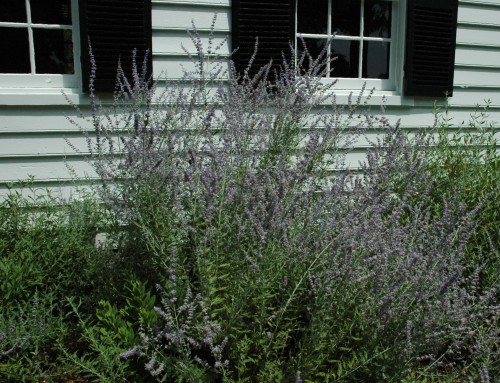
That is the best description for Perovskia, or Russian Sage, when it is in bloom. The hardy ( Zones 5-9) perennial will give years of low maintenance, long summer blooms. Blue panicles create a lavender – blue mist which gets more intense as the flowers open. I like to use this plant as a specimen, mass planting to create a large stand. These beds are easy to maintain and offer color for much of the summer. Each plant grows 3-5′ tall with a 2-4′ spread; planting 2-3 feet apart, they will grow together as a large shrubby mass. They are also live many years, and are tolerant of poor soil. The planting outside of my late father in law’s office has been blooming for over 15 years with little to no attention.
The leaves are finely cut with a distinct blue- green color, which contrast beautifully with the blue mist of the flowers. As mentioned, Perovskia makes a great specimen plant, but also blends well into a mixed perennial bed. If more is desired, the blue mist can be accentuated with plantings of Rudbeckia. Maintenance is as simple as a late winter pruning of all stems to 6″. Where the growing season allows, deadheading will result in reblooms. Having no serious pest from the insect or disease world, it is a perfect perennial for beginner and experienced gardeners. Being so easy to grow in full sun, the challenge is making the most of the Blue Mist.
by Briscoe White | Jun 25, 2010 | Flowers, Gardening |
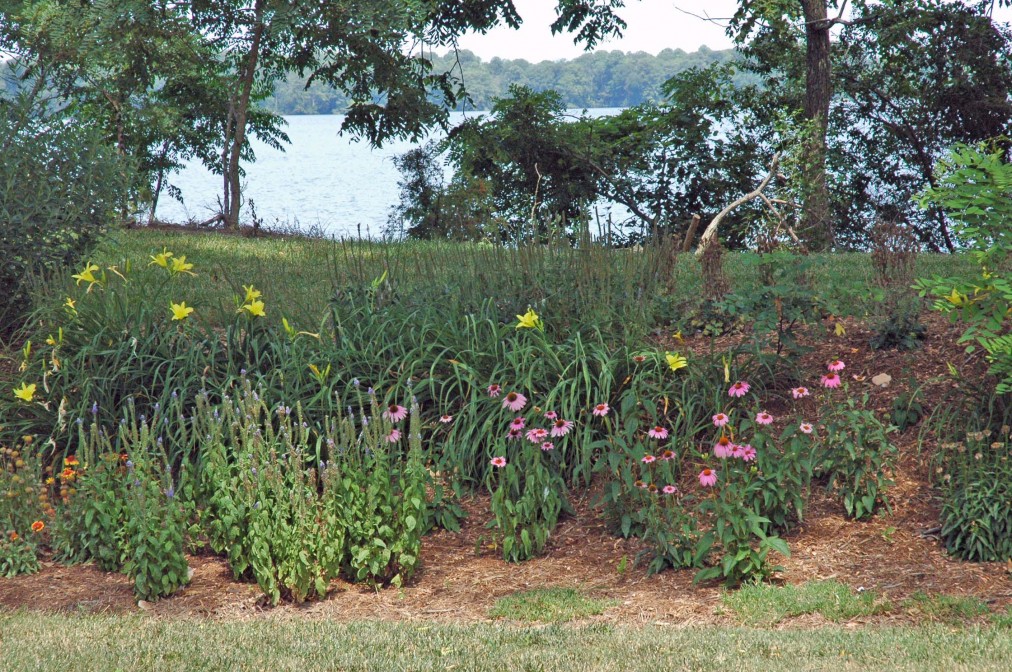

After every season there are always some plants that did not find a home. In the greenhouse, we have to be merciless and allow no survivors at the end. Plants that are divided or potted up are spared because they have found a new reason for being in the next season. Left over annual plants fill our containers.
So, sometimes we are left with perfectly good plants with nowhere to go. Here is where the lucky ones end up. A lot are planted around our farm; we have learned to concentrate planting where they can be tended a little. The hot dry summer is a threat to all new planting unless water is available. Our beds are along the entrance road and around living areas.
The picture shows what we did with some left over perennials. A low drop off behind our pool and always been an eyesore; hardly anything would grow there. Some Ansomnia had grown to very large clumps and a few daylilies hung from the steepest part. I had to water several times a week to get the plants through summer, but it was worth the effort. So, last summer, with the assistance of some hardworking just-graduated seniors, we were able to give those leftovers a second chance. Now, in the INTENSE heat of our end of June days (yesterday was 101!) this bed is hanging on with little to no attention. Notice the coneflowers?
by Briscoe White | Jun 18, 2010 | Flowers, Growing, Miscellaneous |
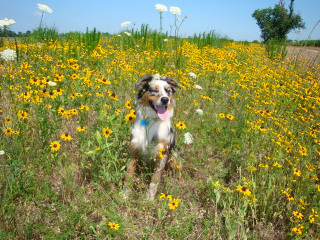
It has been so long since I made a journal entry that I do not even remember when! All I can say about the last few months is that we sent out a lot of plants from our farm. Many thanks to all our gardening customers, may your plants always grow to their full potential!
Now that the shipping season for spring is done, and the fall catalog safely with the printer, we find ourselves beginning what may be a long hot summer. The vegetables are growing and peaches being picked, so all of our summer chores seem to revolve around eating! Being how we are though, flowers will be found on any ground not already occupied.
Last fall, I showed pictures of my seed collecting efforts. This past time takes place while driving; if I see a plant I want, I stop and mark it with flagging tape. It is really hard to relocate plants without a marker, since the original marker is now long gone to seed. This picture is one of the grass filters, which surround all of our fields. Grasses work well, but a few wildflowers turn it into a little prairie, which are always a wonder to behold! Flowers bring a host of winged creatures to colonize this man made habitat: Dragonflies and Butterflies, Bluebirds and Goldfinches fill a pallet of color in constant motion. But, my favorite is the constantly soaring Marsh Hawk, not seen in our fields before the prairies were planted. You don’t have to believe me, look at the picture, it can’t do justice to maybe a hundred thousand flowers.
By the way, that’s our newest pup, an Aussie named ‘Blue’. A great dog …
by Briscoe White | Apr 19, 2010 | Flowers, Growing |
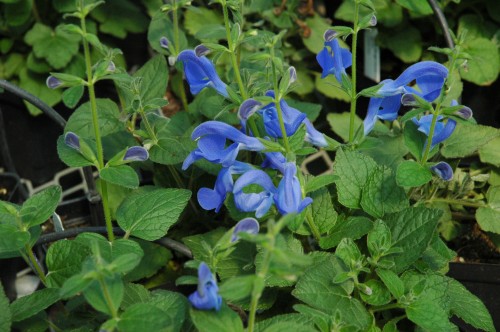
I often wonder where I’d be without loyal customers .. not only because of their financial support, but also for their emotional and practical support! We’ve been in business, growing and selling, for over 25 years and in that time, ‘Martha’ has been their since day one … a great customer who buys lots of plants, a talented gardener, and one of those folks who loves to share her knowledge and her opinion of good plants. I always listen, and that is why we are offering a great salvia.
Salvia ‘Oceana Blue’ has GREAT color .. blues in the garden are something special and this salvia is gorgeous. It is tall, it is drought tolerant, it attracts hummingbirds, butterflies but NOT deer. And, in our garden, it makes a great cut flower for a summer arrangement.
But, this isn’t all about the plant … it’s actually all about the customer. You know who you are … Thanks Martha!







